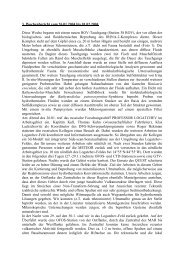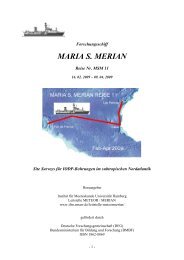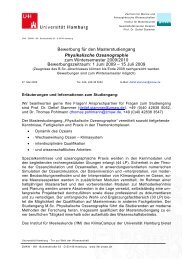MSM01_Expeditionsheft.pdf - Institute of Oceanography, University ...
MSM01_Expeditionsheft.pdf - Institute of Oceanography, University ...
MSM01_Expeditionsheft.pdf - Institute of Oceanography, University ...
Erfolgreiche ePaper selbst erstellen
Machen Sie aus Ihren PDF Publikationen ein blätterbares Flipbook mit unserer einzigartigen Google optimierten e-Paper Software.
Wissenschaftliches Programm<br />
Die multidisziplinäre Forschungsfahrt befasst<br />
sich mit biologischen, geologischen<br />
und hydrographischen Fragestellungen in<br />
die Schlammvulkan Provinz im Golf von<br />
Cadiz. Sie ist in 2 Unterabschnitte geteilt<br />
und beginnt in Kiel, gefolgt von einem Zwischenstopp<br />
in Cadiz (Spanien) und endet in<br />
Lissabon (Portugal).<br />
Die Reise führt in die Schlammvulkanprovinz<br />
des Golf von Cadiz zur Untersuchungen<br />
von benthischen biogeochemischen<br />
St<strong>of</strong>fumsätzen, Fluid und Gas Flüssen, und<br />
spezifischen Ökosystemen wie anoxischen<br />
Lebensgemeinschaften und azooxanthellaten<br />
Steinkorallen.<br />
Ein Teil der Untersuchungen wird im Rahmen<br />
des „Geotechnologien” Programms des<br />
BMBF und der DFG für den Schwerpunkt<br />
„Methan im Geo-/Biosystem” durch das am<br />
IFM-GEOMAR koordinierte und für das<br />
ebenfalls hier schwerpunktmäßig angesiedelte<br />
Programm COMET (Controls on methane<br />
fluxes and their climatic relevance in<br />
marine gas hydrate-bearing environments)<br />
durchgeführt. Ein weitererTeil der Ausfahrt<br />
dient den Untersuchungen im Rahmen des<br />
FP-6 Programms der EU „Hotspot Ecosystem<br />
Research on the Margins <strong>of</strong> European<br />
Seas“ (HERMES). Aus dem HERMES-<br />
Programm nehmen 6 Partner teil.<br />
Die Region des Golf von Cadiz hat eine sehr<br />
komplexe geologische Geschichte. Sie ist<br />
seit der Trias durch mehrere tektonische<br />
Phasen mit Extension, Kompression und<br />
Lateralverschiebungen gekennzeichnet.<br />
Während des Mesozoikums und frühen Känozoikums<br />
bildeten sich in diesem Gebiet<br />
Bruchzonen mit Halbgraben-Strukturen und<br />
Karbonatplattformen. Im Torton verlagerte<br />
sich der Gibraltar-Bogen nach Westen. Dadurch<br />
wurde der Golf von Cadiz zu einem<br />
Forearc-Becken, in das Olistostrome<br />
(Rutschmassen) hineinglitten. In diesem<br />
Ablagerungsmilieu, das sonst für Akkreti-<br />
Fahrtabschnitt / Leg <strong>MSM01</strong>/3<br />
12.04. – 19.05.2006<br />
Kiel – Cadiz - Lissabon<br />
Fahrtleiter / chief scientist Dr. O. Pfannkuche<br />
- 21 -<br />
Scientific Program<br />
This multidisciplinary cruise addresses biological,<br />
geological and hydrographical objectives<br />
in the mud mound province <strong>of</strong> the<br />
Gulf <strong>of</strong> Cadiz. It is divided in two sub legs<br />
starting in Kiel (Germany) with an intermediate<br />
stop in Cadiz (Spain) and ends in Lisbon<br />
(Portugal).<br />
The cruise leads into the mud mound province<br />
<strong>of</strong> the Gulf <strong>of</strong> Cadiz. Main Objectives<br />
are the measurement <strong>of</strong> benthic boundary<br />
layer bio-geochemical fluxes, fluid and gas<br />
flows and investigations <strong>of</strong> specific ecosystems<br />
such as anoxic chemosynthetically<br />
based sediment communities and<br />
azooxanthellate stone corals. Investigations<br />
are partly carried out in the frame <strong>of</strong> the<br />
“Geotechnology “ Programm <strong>of</strong> the German<br />
Federal Ministry <strong>of</strong> Education and Research.,<br />
namely by the IFM-GEOMAR<br />
based programme COMET (Controls on<br />
methane fluxes and their climatic relevance<br />
in marine gas hydrate-bearing environments).<br />
Another part <strong>of</strong> the expedition is<br />
dedicated to investigations in the frame <strong>of</strong><br />
the EU FP-6 programme HERMES (Hotspot<br />
Ecosystem Research on the Margins <strong>of</strong><br />
European Seas). 6 HERMES partners participate<br />
in the cruise.<br />
The Gulf <strong>of</strong> Cadiz has a very complex geological<br />
history and has undergone several<br />
episodes <strong>of</strong> rifting, compression and strikeslip<br />
motion since the Triassic. During the<br />
Mesozoic and the early Cenozoic, the area<br />
was undergoing rifting, with the formation<br />
<strong>of</strong> half-graben structures and carbonate<br />
platforms . The westward migration <strong>of</strong> the<br />
Gibraltar arc during the Late Tortonian<br />
caused the Gulf <strong>of</strong> Cadiz to form as a<br />
forearc basin and induced the emplacement<br />
<strong>of</strong> an olistostrome, in an accretionary<br />
wedge-type depositional environment,<br />
strongly deforming the sediments derived



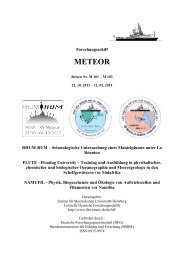

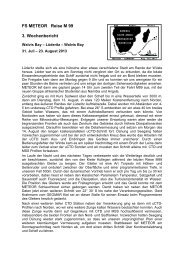
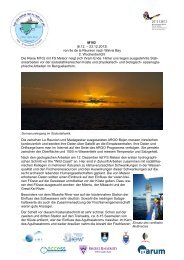
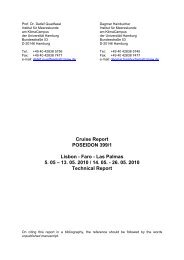
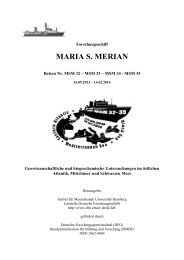
![Expeditionsheft Reisen M99-M100 [pdf] - Institute of Oceanography ...](https://img.yumpu.com/22533092/1/184x260/expeditionsheft-reisen-m99-m100-pdf-institute-of-oceanography-.jpg?quality=85)
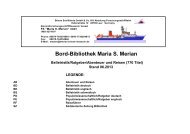
![Darstellungen [pdf]](https://img.yumpu.com/22533086/1/184x260/darstellungen-pdf.jpg?quality=85)



